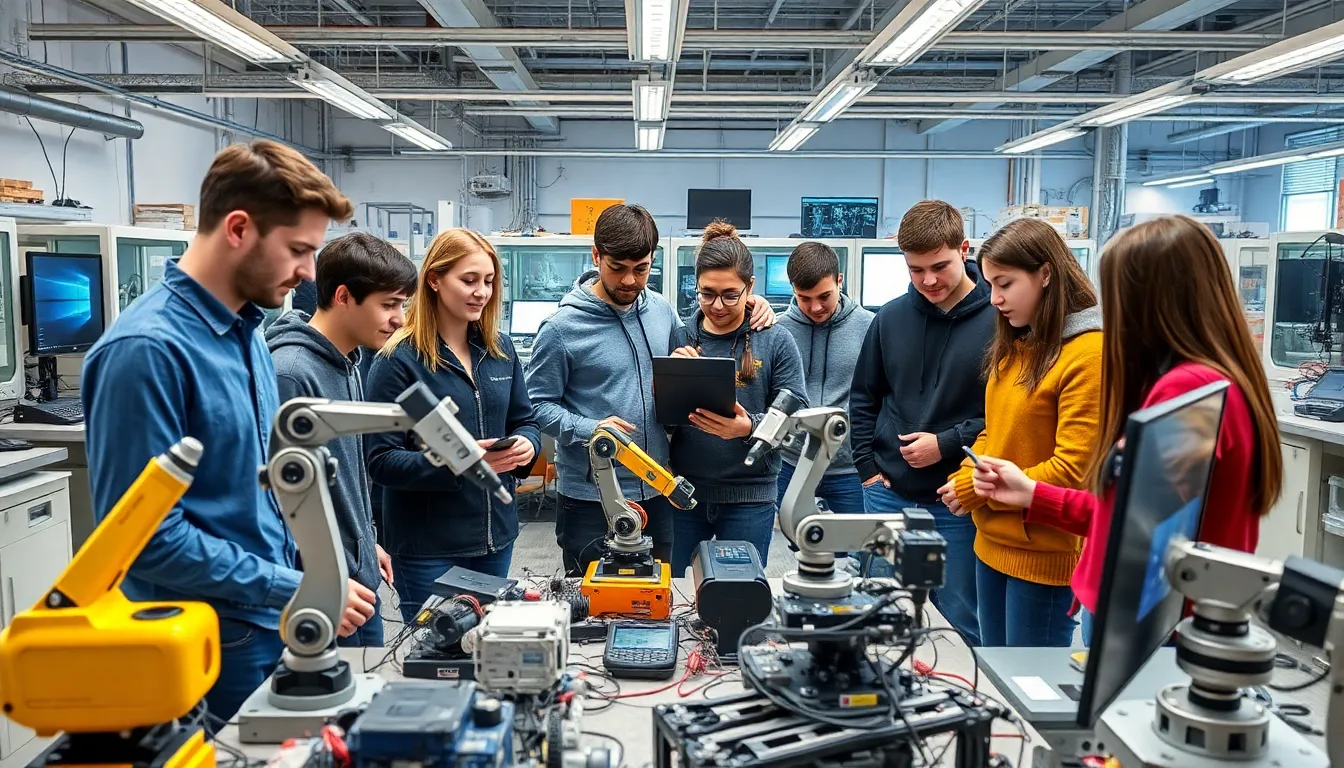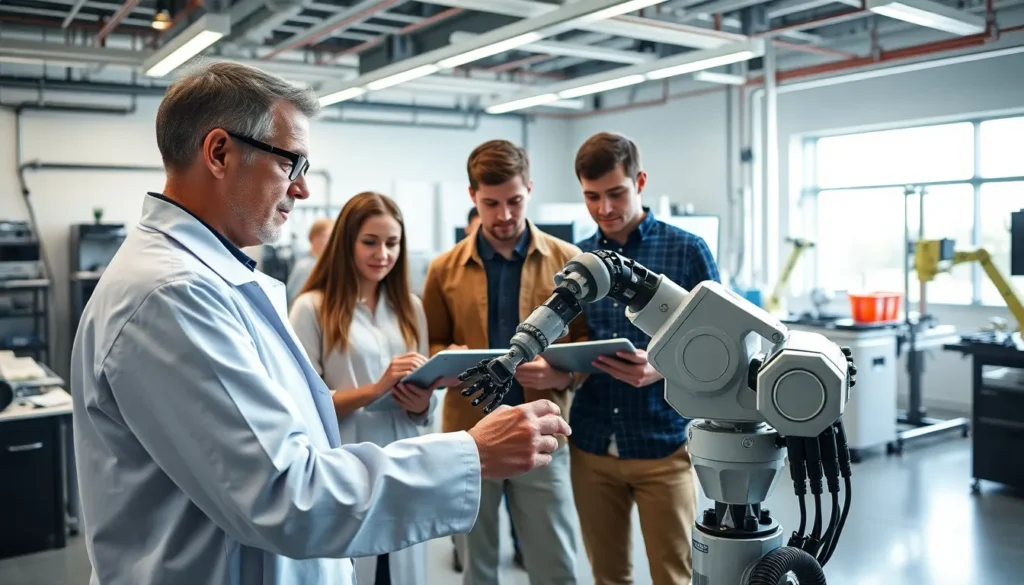Table of Contents
ToggleIn today’s fast-paced world, robotics tools are transforming industries and redefining what’s possible. From manufacturing to healthcare, these innovative technologies streamline processes and enhance productivity like never before. As businesses seek to stay competitive, understanding the landscape of robotics tools becomes crucial.
Robotics tools encompass a wide range of devices and software that enable automation and precision in various tasks. Whether it’s robotic arms assembling products or software algorithms optimizing workflows, these tools are paving the way for a smarter future. As advancements continue to emerge, exploring the capabilities and applications of robotics tools is essential for anyone looking to harness their potential.
Overview of Robotics Tools
Robotics tools encompass a variety of devices and software designed for automation and precision in tasks. These tools include mechanical arms, sensors, controllers, and software platforms. Each component plays a critical role in the functionality and efficiency of robotic systems.
Types of Robotics Tools
- Mechanical Arms: Used in assembly lines, these arms automate repetitive tasks, enhancing speed and reducing errors.
- Sensors: Instruments that gather data from the environment, sensors improve robotic decision-making by providing real-time feedback.
- Controllers: Devices that manage robotic actions and processes, ensuring accuracy in task execution.
- Software Platforms: Programs designed for programming and simulation, these platforms streamline the development and testing of robotic applications.
Applications of Robotics Tools
- Manufacturing: Robotics tools automate production processes, significantly increasing output while maintaining quality.
- Healthcare: Robotic surgical systems and telemedicine applications enhance patient care by increasing precision and improving access to medical expertise.
- Logistics: Automated guided vehicles (AGVs) and drones optimize warehouse operations and delivery systems, reducing downtime.
- Agriculture: Robotics tools like drones and harvesters improve crop monitoring and automate harvesting, maximizing efficiency.
Benefits of Using Robotics Tools
- Increased Efficiency: Automating processes leads to faster completion of tasks.
- Cost Reduction: Reduced labor costs and minimized human error contribute to overall savings.
- Enhanced Precision: Robotics tools perform tasks with high accuracy, essential in critical fields like surgery and manufacturing.
- Adaptability: Many robotics tools can be programmed for various tasks, providing flexibility in operations.
Organizations looking to harness the capabilities of robotics tools must invest in understanding their functionalities and applications. By doing so, they position themselves competitively in their respective industries.
Types of Robotics Tools

Robotics tools can be classified into various categories based on their applications across industries. Understanding these types is crucial for effective deployment and utilization.
Industrial Robotics Tools
Industrial robotics tools consist of mechanical arms, welding machines, and conveyor systems. Mechanical arms perform tasks such as assembly, painting, and packaging, improving production time and quality. Welding machines facilitate precise metal joining, enhancing the durability of products. Conveyor systems streamline material handling, reducing manual labor and increasing efficiency. Commonly used in manufacturing, these tools automate repetitive tasks, leading to lower operating costs and increased output.
Educational Robotics Tools
Educational robotics tools include programmable kits, robotic platforms, and coding software. Programmable kits allow students to design and build robots, fostering creativity and critical thinking. Robotic platforms provide hands-on experience with real-world applications, enabling learners to understand basic robotics principles. Coding software supports the development of programming skills, promoting computational literacy. These tools engage students in STEM education, preparing them for future careers in technology and engineering.
Research and Development Robotics Tools
Research and development robotics tools encompass simulation software, prototypes, and advanced sensors. Simulation software enables scientists and engineers to model robotic behaviors and systems, minimizing the need for physical testing. Prototypes allow for experimentation and refinement of robotic designs before full-scale production. Advanced sensors enhance data collection and environmental interaction, providing insights for system improvements. These tools drive innovation, allowing researchers to explore new technologies and applications in robotics.
Key Features of Robotics Tools
Robotics tools incorporate essential features that enhance automation, compatibility with artificial intelligence, and ease of use. These characteristics contribute significantly to their effectiveness across various applications.
Automation Capabilities
Robotics tools excel in automation capabilities, allowing for the execution of repetitive tasks with high precision. They reduce human intervention in processes such as assembly lines, packaging, and quality control, leading to increased efficiency and consistency. These tools utilize sophisticated algorithms to optimize workflows, monitor performance metrics, and adapt in real time to changes in the environment.
Integration with AI
Robotics tools increasingly integrate with AI technologies, amplifying their functionality and decision-making processes. This integration enables robots to learn from their environment, recognize patterns, and make informed decisions. For instance, equipped with machine learning capabilities, robotic systems can analyze data and improve operational strategies over time. Applications spanning from autonomous vehicles to smart manufacturing highlight the synergy between robotics and AI.
User-Friendliness
Robotics tools prioritize user-friendliness, ensuring accessibility for operators at various skill levels. Intuitive software interfaces facilitate programming and control, reducing the learning curve. Many robotics tools come with pre-configured templates and drag-and-drop features, allowing users to implement automation solutions quickly. Training resources and community support further enhance usability, making it easier for businesses to adopt and maximize their robotic systems.
Popular Robotics Tools in the Market
Numerous robotics tools currently lead the market, each contributing unique features and functionalities across various industries. Below are two notable examples with specifications and practical use cases.
Tool 1: Specifications and Use Cases
Robot Arm: Specifications and Use Cases
- Specifications: Typically includes multi-axis movement, payload capacity up to several hundred kilograms, and precision of ±0.1 mm. Equipped with sensors and programmable controllers, these robotic arms can perform complex tasks.
- Use Cases: Primarily used in manufacturing for assembly lines, robotic arms automate tasks such as welding, painting, and packaging. They enhance production efficiency and consistency while reducing labor costs.
Tool 2: Specifications and Use Cases
- Specifications: Features include obstacle detection, GPS navigation, and real-time data processing with AI integration. AMRs usually have a range of up to 50 miles on a single charge and can carry loads of up to 1,000 pounds.
- Use Cases: Widely utilized in logistics and warehousing, AMRs streamline inventory management and order fulfillment. They transport materials between different areas without human intervention, significantly improving operational efficiency and safety.
Future Trends in Robotics Tools
Future trends in robotics tools reflect rapid advancements in technology and a shift towards increased automation across various sectors. The integration of artificial intelligence (AI) and machine learning enhances the capabilities of robotics tools, allowing them to perform complex tasks with minimal human oversight. AI-driven robotics can adapt to changing environments, optimizing their operations in real-time.
Collaboration between humans and robots is on the rise, leading to the development of collaborative robots, known as cobots. Cobots are designed to work alongside human operators, enabling a shared workspace that enhances productivity while ensuring safety. This trend promotes a more fluid interaction between technology and labor, allowing businesses to leverage both human creativity and robotic efficiency.
Another vital trend is the miniaturization of robotics tools. Smaller, more agile robotics systems are emerging, facilitating their deployment in confined environments such as small manufacturing workshops and even households. This miniaturization allows for greater flexibility and expanded applications in everyday tasks, making robotics tools accessible to a broader audience.
Moreover, the growth of the Internet of Things (IoT) plays a significant role in shaping the future of robotics. IoT-enabled robotics tools can communicate with other devices over networks, providing real-time data analytics and seamless integration into smart ecosystems. Improved connectivity enhances operational efficiency and allows for remote monitoring and control.
Additionally, advancements in sensor technologies significantly improve the precision and reliability of robotics tools. Sensors equipped with enhanced capabilities, such as 3D vision and tactile feedback, enable robots to interact more effectively with their surroundings. These technologies contribute to higher accuracy in tasks ranging from surgical procedures in healthcare to material handling in manufacturing.
The emergence of customizable robotics tools is also noteworthy. Companies are increasingly offering modular designs that allow users to tailor robotics systems to their specific needs. This customization enhances the adaptability of tools, enabling organizations to address unique operational challenges effectively.
Lastly, sustainability trends influence the development of robotics tools. Companies are focusing on creating energy-efficient robots that minimize environmental impacts. This approach not only reduces operational costs but also aligns with global efforts towards sustainability and responsible resource management.
Robotics tools are revolutionizing industries by enhancing efficiency and precision. As businesses adapt to these advancements they gain a competitive edge through automation and improved processes. The integration of AI and IoT technologies further amplifies their capabilities allowing for smarter and more responsive systems.
With trends pointing towards miniaturization and sustainability the future of robotics tools looks promising. Organizations that invest in understanding and implementing these technologies will not only streamline their operations but also position themselves as leaders in their fields. Embracing robotics tools is no longer an option; it’s a necessity for those aiming to thrive in an ever-evolving landscape.




